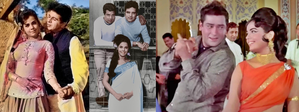New Delhi: She would have remained a B-grade film heroine, save for one standout moment when she became the first actress to rock and roll in a saree, with no top actor of the time ready to accept her as a co-star. Thankfully for Mumtaz, Dilip Kumar had no such hang-ups.
During casting for “Ram Aur Shyam” (1967), her name was suggested to Dilip Kumar as the romantic partner for one of the twins he would play. The thespian was first undecided but on being shown videos of her performances so far, remarked she was “a scene stealer” and agreed to take her on. She took with gusto to the role of Shanta, who has a bantering relationship with the boisterous Shyam, but eventually finds her real partner in the timid and oppressed Ram.
However, a one-off would not have been enough to catapult Mumtaz, who celebrates her 77th birthday on this day (July 31) to the top league. But the actress, who was as determined as she was talented, was up to the task.
She cemented her presence with the romantic potboiler “Patthar Ke Sanam”, in which as Meena, the second lead, her elfin charm was a foil to Waheeda Rehman’s grace, then, as Shabnam, Sunil Dutt’s spirited onscreen partner, in whodunnit “Hamraaz”, Shefali in V. Shantaram’s “Boond Jo Ban Gayee Moti” (all 1967) and then, Reena in “Do Raaste” (1969) – the first of her 10-odd hit films with Rajesh Khanna.
The icing was Shammi Kapoor’s “Brahmachari” (1968), in which she played a vamp out to dupe the promiscuous villain, and jived in a saree in “Aaj kal tere mere pyaar ke charche”. A special one was created for the purpose by ace designer Bhanu Atheya, with inbuilt pleats and a zipper down one side! It would go to be known as the “Mumtaz saree”.
In “Khilona” (1970), Mumtaz bravely took up the role of a prostitute, after many others turned it down, and went on to win her first and only Filmfare Award. She held her own against Zeenat Aman as Dev Anand’s love interest in “Hare Rama Hare Krishna” (1971).
Born to an Indian father and an Iranian mother in 1947 – a fortnight before Independence, Mumtaz Askari had her first experience of the film world when young and became a child artiste at 11. However, as she turned adult, she only managed small roles in films like Sunil Dutt’s stark “Mujhe Jeene Do” (1963), or at best, the second heroine in the Persian epic-inspired “Rustam Sohrab” (1963) – the swan song of Suraiya – where Mumtaz played Sohrab’s (Prem Nath) love interest.
A real-life strongman seeking to turn into a reel-life strongman came to her aid. Dara Singh accepted her as a co-star and they did a string of action thrillers – “Veer Bhimsen”, “Samson”, “Hercules” (all 1964), “Tarzan Comes to Delhi”, “Tarzan and King Kong”, “Son of Hatimtai”, “Sikandar-e-Azam”, “Rustom-e-Hind”, “Jadui Angoothi” (all 1965), “Daku Mangal Singh” (1966), and so on.
While she was making fairly decent money, Mumtaz could have been trapped in this rut, had not her chance with Dilip Kumar given her an opportunity to enter the top league.
With her large smoky eyes that could portray everything from saucy innocence to sparkling sensuality to hurt anguish, dancing skills, and a readiness to experiment, she easily transitioned to become a top heroine and a style icon.
In the process, many heroes, who had spurned her earlier, would now request her to star with them, and she gracefully acceded, even, as a reigning superstar, with whom she had a string of successes, reportedly went into a sulk if she acted with other heroes.
A highlight of her film foray was her kinetic performances in a spate of evergreen songs – the gay abandon of “Jai Jai Shiv Shankar” (“Aap Ki Kasam”, 1974), the intrinsic playfulness of “Gore rang pe na ghuman kar”, and the silliness of “Chal dariya mein kud jaaye” (“Prem Kahani”, 1975) – all with Rajesh Khanna, “Main tere ishq mein” and “Koi Shahri Babu” (“Loafer”) with Dharmendra and the brazen “Le jayenge, le jayenge dilwale dulhaniya le jayenge” (“Chor Machaye Shor”, 1974) with Shashi Kapoor.
She made her presence felt in even those where she was merely serenaded — “Phir tumhari yaad aayi hai sanam” (“Rustam Sohrab”), “Tauba yeh matwali chaal” (“Patthar Ke Sanam”), and “Aaj mausam bada beimaan hai” (“Loafer”).
However, Mumtaz never took her fortune for granted and less than a decade as one of Bollywood’s most popular actresses, bid adieu at the peak of her fame, having married a rich NRI businessman. She did attempt a comeback in 1990 but it it did not work out, and she only returned onscreen in a 2010 breast cancer documentary, having survived the disease herself.
(Vikas Datta can be contacted at vikas.d@ians.in)
–IANS


Comments are closed.